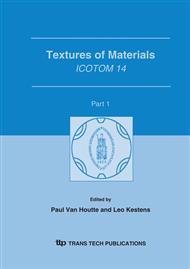p.977
p.983
p.989
p.995
p.1001
p.1007
p.1013
p.1019
p.1025
Modeling Texture, Twinning and Hardening Evolution during Deformation of Hexagonal Materials
Abstract:
Hexagonal materials deform plastically by activating diverse slip and twinning modes. The activation of such modes depends on their relative critical stresses, function of temperature and strain rate, and the orientation of the crystals with respect to the loading direction. For a constitutive description of these materials to be reliable, it has to account for texture evolution associated with twin reorientation, and for the effect of the twin barriers on dislocation propagation and on the stress-strain response. In this work we introduce a model for twinning which accounts explicitly for the composite character of the grain, formed by a matrix with embedded twin lamellae which evolve with deformation. Texture evolution takes place through reorientation due to slip and twinning. The role of the twins as barriers to dislocations is explicitly incorporated into the hardening description via a directional Hall-Petch mechanism. We apply this model to the interpretation of compression experiments both, monotonic and changing the loading direction, done in rolled Zr at 76K.
Info:
Periodical:
Pages:
1001-1006
Citation:
Online since:
September 2005
Authors:
Keywords:
Price:
Сopyright:
© 2005 Trans Tech Publications Ltd. All Rights Reserved
Share:
Citation:


